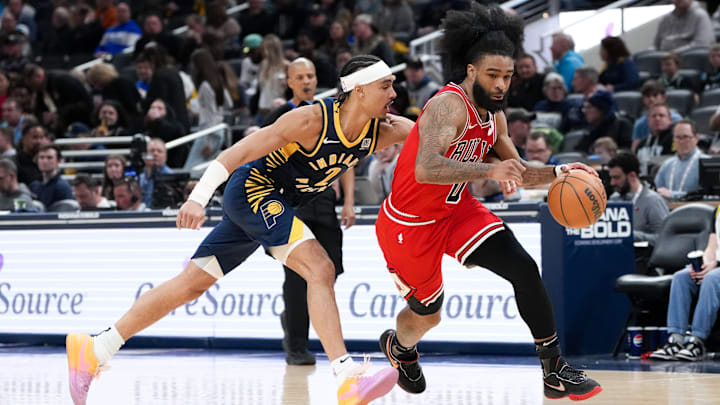The Chicago Bulls have undergone a major transformation over the past two years. From moving on from longtime cornerstones to fully embracing a new offensive philosophy, this team will look drastically different from the start of last season—and nearly unrecognizable compared to the 2023–24 campaign.
Long gone are the days of DeMar DeRozan, Zach LaVine, Alex Caruso, and Lonzo Ball. Chicago now revolves around two holdovers, Coby White and Nikola Vucevic, flanked by Matas Buzelis and Josh Giddey, with a roster reshaped for a new direction.
Pace defines the Bulls’ offensive identity
Yet the seismic roster shakeup isn’t even the most staggering change; it’s the Bulls’ offensive transformation. In 2023–24, Chicago led the league in mid-range attempts, ranked 23rd in assists, 26th in three-point attempts, and 28th in pace.
In 2024–25, the Bulls ranked 27th in mid-range attempts, fifth in assists, third in three-point attempts, and second in pace. What a difference a season makes. Billy Donovan installed a new offensive philosophy, and while Chicago’s offensive rating actually dipped by 0.8 points, the team finished with the same record, despite fielding a thinner roster and moving on from Caruso, DeRozan, and LaVine.
Despite the slight dip in offensive rating, Donovan appears to be onto something. Last season’s NBA Finals participants, Oklahoma City and Indiana, ranked fifth and seventh in pace, respectively. Both teams also emphasized ball movement: the Pacers finished third in assists, while the Thunder ranked 12th.
The Bulls may not have a perennial MVP candidate like Shai Gilgeous-Alexander to anchor their offense, or a rising duo like Jalen Williams and Chet Holmgren. So, it’s fair to say the Thunder comparison only goes so far. But Chicago might be closer to Indiana than one might think.
The Indiana Pacers: A blueprint for non-star teams
In ESPN’s NBA Season Preview, Jamal Collier drew a comparison between the two Central Division foes, highlighting pace as the Bulls’ biggest strength before noting: “The Bulls are trying to model the [Pacers’] same style: multiple ball handlers, shooting everywhere and an offense built on randomness to put pressure on opposing defenses from all angles.”
In Collier’s example, Giddey and White serve as the primary ball handlers, nearly everyone on the roster can shoot, and defenses can’t key in on a single player. On any given night, Giddey, White, Vucevic, or ascending young talent Matas Buzelis could each put up 20 points.
The Bulls may lack the Pacers’ hoard of defensive stoppers, but offensively, the parallels are striking. Giddey mirrors Tyrese Haliburton—a pass-first floor general who thrives on pace and movement. Buzelis projects as a Pascal Siakam–type forward with size, versatility, and scoring touch. And Chicago still has Coby White, perhaps a better pure scorer than anyone on Indiana’s roster, though his game blends elements of fellow guards Bennedict Mathurin and Andrew Nembhard.
If Chicago had a 3-and-D wing like Aaron Nesmith (Dalen Terry or Julian Phillips?) and a shot-blocking, floor-spacing five like the Pacers used to have in Myles Turner, the two teams would be nearly indistinguishable.
All in all, the most glaring comparison is that both teams’ builds lack a true superstar. Conventional wisdom once held that a superstar—or even a few—was crucial for advancing to the NBA Finals. With today’s strict salary cap restrictions, that mindset is no longer relevant. Of course, Chicago still needs a reliable primary scorer, but an offense with threats all over the court can offset the need for a traditional All-Star bucket-getter.
